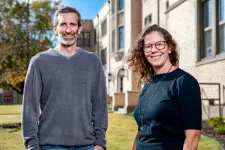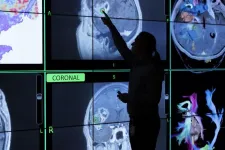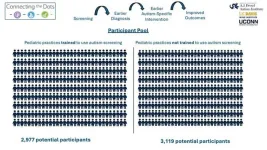(Press-News.org) If every American over the age of 40 was as physically active as the top 25% of the population, they could expect to live an extra 5 years, on average, suggest the findings of a modelling study published online in the British Journal of Sports Medicine.
And if the least physically active matched the level of the most physically active, they could live almost 11 years longer, the estimates indicate.
It’s well known that low physical activity levels are associated with a higher risk of diseases, such as heart disease and stroke, as well as premature death, but it’s not clear to what extent low physical activity levels shorten lifespan in specific groups of people or countries, such as the USA.
To try and find out, the researchers created a predictive model to estimate the impact of different levels of increased physical activity on life expectancy.
They based their model on physical activity risk estimates derived from activity tracker data from the 2003–06 National Health and Nutritional Examination Survey for people aged at least 40, plus 2019 population data from the U.S. Census Bureau and deaths recorded in 2017 from the National Centre for Health Statistics.
The total physical activity of the most active 25% of Americans over the age of 40 was equivalent to 160 minutes of normal paced walking at 4.8 km/(3 miles)/hour every day.
Based on this, the researchers estimated that if all the over 40s in the US matched this level of physical activity every day, their average lifespan would increase by just over 5 years, boosting life expectancy at birth to nearly 84 years from 78.6 years.
And if the least physically active 25% of the population matched the levels of the most physically active 25%, they would need to clock up an extra 111 minutes of walking at 4.8 km/hour every day (or equivalent effort). But this could increase their life expectancy by nearly 11 years, the estimates suggest.
The greatest gain in life for every hour walked was seen among the least physically active, among whom each extra hour of walking could add 376 minutes to their life expectancy—equivalent to around 6 hours. Gains to life expectancy decreased as physical activity rose and on average every extra hour walked could add 169 minutes (2 hours and 49 minutes) to life expectancy.
This is an observational study, and as such, can’t establish cause and effect, and the researchers acknowledge various imitations to their findings. For example, the predictive model they used may have underestimated or overestimated the benefits of physical activity for Americans, because of the research findings on which it drew.
But they nevertheless suggest that increased investment in physical activity promotion and the creation of living environments that foster physical activity have the potential to yield large gains in life expectancy for Americans at the population and individual level.
“Our findings suggest that [physical activity] provides substantially larger health benefits than previously thought, which is due to the use of more precise means of measuring [it],” they write.
“The greatest gain in lifetime per hour of walking was seen for individuals in the lowest activity quartile where an hour’s walk could add an impressive 6 hours to life.”
But the researchers acknowledge that increasing physical activity at the population level is a complex task that requires a systems-wide approach.
“Infrastructure measures that encourage active transport, walkable neighbourhoods, as well as green spaces might be promising approaches to increase physical activity and resultant healthy life expectancy at the population level,” they suggest.
[Ends]
END
US over 40s could live extra 5 years if they were all as active as top 25% of population
And for the least physically active this could mean living nearly 11 more years
2024-11-15
ELSE PRESS RELEASES FROM THIS DATE:
Limit hospital emissions by using short AI prompts - study
2024-11-15
Hospitals must use artificial intelligence responsibly to avoid huge carbon emissions, new research has shown.
Released before Technology Day (Saturday, 16 November) at the COP29 climate conference in Baku, Azerbaijan, a study investigating the impact of artificial intelligence in healthcare has shown that using large language models to process thousands of patient records daily across multiple hospitals could lead to substantial resource consumption.
Published today (Friday, 15 November) in Internal Medicine Journal, researchers from the University ...
UT Health San Antonio ranks at the top 5% globally among universities for clinical medicine research
2024-11-14
SAN ANTONIO, Nov. 14, 2024 – The race to draw the best and brightest students has become an international one, with candidates weighing options not only in their state or country, but also across the globe. Universities likewise face fierce competition globally for top scientists and research funding.
The University of Texas Health Science Center at San Antonio (UT Health San Antonio) was ranked at the top 5% of universities in the world (No. 51 out of the top 1,000) in the U.S. News & World Report’s 2024-2025 Best Global Universities ...
Fayetteville police positive about partnership with social workers
2024-11-14
In 2021, the University of Arkansas School of Social Work partnered with the Fayetteville Police Department to pair officers with social workers trained to help people suffering mental crises. Initially, the officers were supportive of the effort but also somewhat hesitant. Now that the co-response teams are fully established, the officers say the program benefits the community and helps them carry out their duties.
The officers’ changing attitudes to the program were reported in the latest issue of the Journal of Police and Criminal Psychology. The paper was written by U of A social work professors Mark Plassmeyer and Kim Stauss, who helped launch and continue ...
Optical biosensor rapidly detects monkeypox virus
2024-11-14
A new variant of human mpox has claimed the lives of approximately 5% of people with reported infections in the Democratic Republic of the Congo since 2023, many of them children. Since then, it has spread to several other countries. The World Health Organization declared the outbreak a Public Health Emergency of International Concern on August 14. In addition, a different but rarely fatal mpox variant was responsible for an outbreak that has spread to more than 100 countries since 2022.
There is an urgent need for faster and ...
New drug targets for Alzheimer’s identified from cerebrospinal fluid
2024-11-14
A multitude of genes have been linked to the development of Alzheimer’s disease. Specifically how those genes might influence the progression of neurodegeneration remains something of a black box though, in part because of the challenges of examining in molecular detail the brain of a living patient.
Using cerebrospinal fluid (CSF) collected from living patients, a team of researchers at Washington University School of Medicine in St. Louis has for the first time linked disease-related proteins and genes to identify specific cellular pathways responsible for Alzheimer’s ...
Neuro-oncology experts reveal how to use AI to improve brain cancer diagnosis, monitoring, treatment
2024-11-14
INDIANAPOLIS — An international, multidisciplinary team of leading neuro-oncology researchers and clinicians has released new recommendations for good clinical practice — a set of guidelines that helps ensure clinical trial results are reliable, and patients are protected — regarding the use of artificial intelligence methods to more accurately diagnose, monitor and treat brain cancer patients.
The team recently published two companion policy reviews in The Lancet Oncology, on behalf of the ...
Argonne to explore novel ways to fight cancer and transform vaccine discovery with over $21 million from ARPA-H
2024-11-14
The U.S. Department of Energy’s (DOE) Argonne National Laboratory will use its world-leading capabilities in artificial intelligence (AI) and high performance computing to research novel ways to fight cancer and transform vaccine discovery.
The two awards, totaling up to $21.7 million, are from the Advanced Research Projects Agency for Health (ARPA-H), part of the U.S. Department of Health and Human Services. Established in 2022, ARPA-H’s mission is to accelerate transformative ...
Firefighters exposed to chemicals linked with breast cancer
2024-11-14
It’s well documented that firefighters have significantly higher rates of cancer than the general population, and these elevated rates have been associated with exposures to toxic chemicals on the job. However, most research on cancer in firefighters has been done in men and less is known about the risks in women.
Now a new study by Silent Spring Institute has identified multiple chemical exposures that firefighters face on the job that could increase their risk of developing breast cancer.
“With more and more women entering the profession, it’s important to understand the impact of workplace exposures on their health so that we can inform policies to reduce ...
Addressing the rural mental health crisis via telehealth
2024-11-14
The Medical University of South Carolina has been awarded $1.75 million from the Health Resources and Services Administration to develop and test the effectiveness and sustainability of the SC Rural Telehealth-enabled Collaborative Care Network (SC-RTECC). The SC-RTECC will deliver psychiatric collaborative care management to 1500 primary care patients over a five-year period in seven diverse, rural, underserved South Carolina counties.
The goal of the project is to test whether telehealth can be used to deliver psychiatric collaborative care management efficiently and sustainably at rural primary care clinics in South Carolina.
The project will be led by Ryan ...
Standardized autism screening during pediatric well visits identified more, younger children with high likelihood for autism diagnosis
2024-11-14
New research from Drexel University’s A.J. Drexel Autism Institute found that the use of standardized autism screening during pediatric well-child visits identifies more children with high autism likelihood at a younger age, including those presenting with more subtle symptoms. This is the first large-scale, randomized trial to test the impact of standardized autism screening on early detection of autism in pediatric primary care.
Recently published in the Journal of the American Academy of Child & Adolescent Psychology, the multi-site ...
LAST 30 PRESS RELEASES:
Why nail-biting, procrastination and other self-sabotaging behaviors are rooted in survival instincts
Regional variations in mechanical properties of porcine leptomeninges
Artificial empathy in therapy and healthcare: advancements in interpersonal interaction technologies
Why some brains switch gears more efficiently than others
UVA’s Jundong Li wins ICDM’S 2025 Tao Li Award for data mining, machine learning
UVA’s low-power, high-performance computer power player Mircea Stan earns National Academy of Inventors fellowship
Not playing by the rules: USU researcher explores filamentous algae dynamics in rivers
Do our body clocks influence our risk of dementia?
Anthropologists offer new evidence of bipedalism in long-debated fossil discovery
Safer receipt paper from wood
Dosage-sensitive genes suggest no whole-genome duplications in ancestral angiosperm
First ancient human herpesvirus genomes document their deep history with humans
Why Some Bacteria Survive Antibiotics and How to Stop Them - New study reveals that bacteria can survive antibiotic treatment through two fundamentally different “shutdown modes”
UCLA study links scar healing to dangerous placenta condition
CHANGE-seq-BE finds off-target changes in the genome from base editors
The Journal of Nuclear Medicine Ahead-of-Print Tip Sheet: January 2, 2026
Delayed or absent first dose of measles, mumps, and rubella vaccination
Trends in US preterm birth rates by household income and race and ethnicity
Study identifies potential biomarker linked to progression and brain inflammation in multiple sclerosis
Many mothers in Norway do not show up for postnatal check-ups
Researchers want to find out why quick clay is so unstable
Superradiant spins show teamwork at the quantum scale
Cleveland Clinic Research links tumor bacteria to immunotherapy resistance in head and neck cancer
First Editorial of 2026: Resisting AI slop
Joint ground- and space-based observations reveal Saturn-mass rogue planet
Inheritable genetic variant offers protection against blood cancer risk and progression
Pigs settled Pacific islands alongside early human voyagers
A Coral reef’s daily pulse reshapes microbes in surrounding waters
EAST Tokamak experiments exceed plasma density limit, offering new approach to fusion ignition
Groundbreaking discovery reveals Africa’s oldest cremation pyre and complex ritual practices
[Press-News.org] US over 40s could live extra 5 years if they were all as active as top 25% of populationAnd for the least physically active this could mean living nearly 11 more years




